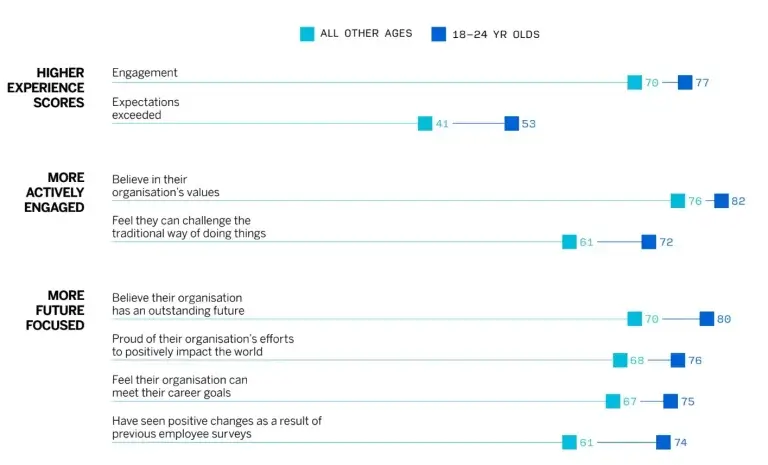Attracting the best people to come and work for you is difficult, and the last thing you want to happen is that they leave, finding better personal development and growth opportunities, or new challenges elsewhere.
Employees these days are tending not to stay in one job long term. This is especially true of younger talent. Our research found that although people aged under 25 are the most engaged and positive of all the employee groups, keener than any other age group to bring value to their organizations, and incredibly optimistic about its future, they are also unwilling to commit to one organization for an extended period of time.
It makes sense, therefore, to hang onto your bright, optimistic, enthusiastic young people for as long as possible. The top factors that make 18-24-year-olds want to stay at an organization are:
- Their career advancement aspirations can be met
- The employee benefits meet their needs
- Managerial behavior is consistent with company values
- Belief in the company values
- Meaningful career progression discussions with their manager

How can you do this? When you foster career mobility, you’ll be able to fulfil all these factors, and engage and retain your valuable employees.
Free eBook: 2025 employee experience trends report
What is career mobility?
Career mobility refers to giving your employees the flexibility and skills to move around and grow within your organization.
The type of mobility depends on the needs of the business and the individual employees’ career goals and ambitions:
- Upward or vertical mobility: promotion to higher levels
- Horizontal or lateral mobility: a sideways move to a different role but at the same level / pay grade
- Hybrid mobility: blending skills by working across different departments
- Role development: developing further responsibilities and skills in an existing position
Why is career mobility important?
Employees used to climb ‘the career ladder’. Nowadays, they negotiate a ‘career lattice’, moving across departments sideways, upwards, diagonally, and maybe even downwards (to experience the shop floor or front line).
Career mobility also avoids another relic from past business thinking – talent hoarding. This is where managers hang onto their star performers and hinder their movement to other areas of the organization. Talent hoarding is a sign that a company is probably not very enlightened, slow to change, and less agile than its competitors. Studies show that transferring employees into diverse roles is one of the best developmental and cultural enhancement strategies in forward-thinking companies today.
Emphasising career mobility shows that you take talent management and employee development opportunities seriously, and is a hallmark of a high-performance organization. When you build a culture of career mobility, people get to know each other and how they work, so you also build interdepartmental cooperation and more cohesive, collaborative teams – leading to long term success.
The benefits of career mobility
The great thing about career mobility is that it benefits both the organization and the employees.
Employers…
Increase employee retention and reduce turnover
It’s expensive to lose those talented employees that you recruited, trained, and resourced. By keeping things fresh with extra skilling and training, and opening new horizons in different departments, you interest and engage employees, and they’ll want to stay.
Attract top talent
Talent is top for a reason – they’re the type who want to work, learn, progress, and be promoted. When you’re an organization that offers a well-defined learning and career development program, those candidates who want professional growth will come knocking on your door – not your competition’s.
Boost employee engagement
Nobody wants to feel stuck in a dead-end job. Enabling career mobility means that your employees will feel interested, motivated and invested in the various different projects and continuous learning opportunities, and enjoy greater engagement and job satisfaction.
Create a skilled, productive workforce
Career mobility initiatives emphasize skill development and dynamic learning, enriching every team and department, and contributing to your organization’s success.
Grow their own leaders
By encouraging career mobility, you can ‘grow your own’ future leaders. You’ll spot promising employees from the start and can begin to prime them for leadership roles. And if you’ve done career mobility right, they’ll want to step seamlessly into more responsible roles – and stay.
Employees…
Enjoy a better employee experience (EX)
Work feels more dynamic, engaging and worthwhile for employees when they are consistently challenged, trained and exposed to new things. With the right support from leaders and managers, employees know that they can progress in their careers, and enjoy an element of stability as they can see a future with the company.
A company that embraces career mobility, fostering collaboration across departments, and strengthening relationships tends to be a forward-thinking one that values a strong workplace culture. Great workplace cultures tend to deliver stellar employee experience.
Whether an employee intends to stay with your organization long term, or use it as a stepping stone to different employers, career mobility gives employees new skill sets, experience in current practices, and different challenges for their personal career transitions. The challenge for you, the employer, is to give them such a great experience that they don’t want to jump ship to a competitor.
In the words of Richard Branson: “Train people well enough so they can leave, treat them well enough so they don’t want to.”
Have higher earning potential
Every skill, role advancement, new experience, and responsibility looks great on a resumé, and increases a person’s earning potential. Be aware it will also empower your people to ask for regular raises, which of course you’ll give them as they’re such great employees (and they may not need to ask).
Consider management and leadership roles
Job mobility gives your employees a solid, holistic grasp of your unique organizational workings and dynamics as they navigate the different roles, work in various functions, and learn specific skills. This overview of the entire business and its workforce hones their strategic and decision-making abilities, preparing them for leadership.
Career mobility programs
Josh Bersin sums up the current climate: “But today, roles are shifting quickly, skills become obsolete faster than, and organizations need to find people for new roles or projects rapidly. At the same time, employees expect to try new work, learn adjacent skills, work with new managers and teams and take international assignments. So, the old model of planning out career moves doesn’t work anymore.”
So how can you fulfil your employees’ expectations for career opportunities and deliver great outcomes for the business? Develop an internal career mobility program. This is an intentional and structured scheme that trains your talent base for transferring to other positions, departments or locations within your organization.
The essence of a career mobility scheme is that it can acknowledge the competencies, skills and experiences of individuals, and deploy them to different projects across the business, rather than sticking rigidly to job roles that limit personal growth.
It will also be unique to your business. Every organization needs different outcomes from their mobility process, so you need to look at your organizational goals, what you want to achieve with the people you have, and how career mobility can help.
Using technology to help with your career mobility program
Understanding your employees is essential for implementing a career mobility program. Employee journey analytics are pivotal to monitor internal mobility. They help highlight the moments that matter along all employees’ lifecycles, such as whether under 25s have been onboarded and trained properly based on feedback. They can also focus on one-to-one meetings with managers and highlight areas for improvement.
People analytics tools will help you uncover the reasons why some people leave and some stay so that you can focus on making the employee experience the best it can be.
For career mobility to work, managers need to be on board with your program, open to diverse perspectives that challenge, contrast with, or differ from their own, and be courageous enough to take them on board. Pulse surveys can really help here. These help leaders and managers to get feedback quickly and accurately, not only from their team, but also from other departments.
And experience data is essential for making business decisions that affect people. This will help you make smarter, better decisions that build trust, identify skill gaps, enhance employee satisfaction, and make career mobility a whole lot easier.



